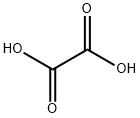Oxalic acid Standard , AnalyticalVolumetricSolution,0.5M , 144-62-7
Synonym(s):
Ethanedioic acid dihydrate;Oxalic acid;Oxalic acid solution
CAS NO.:144-62-7
Empirical Formula: C2H2O4
Molecular Weight: 90.03
MDL number: MFCD00002573
EINECS: 205-634-3
| Pack Size | Price | Stock | Quantity |
| 1L | RMB199.20 | In Stock |
|
| others | Enquire |
PRODUCT Properties
| Melting point: | 189.5 °C (dec.)(lit.) |
| Boiling point: | 365.1°C (estimate) |
| Density | 0.99 g/mL at 25 °C |
| bulk density | 750kg/m3 |
| vapor density | 4.4 (vs air) |
| vapor pressure | <0.01 mm Hg ( 20 °C) |
| refractive index | 1.4261 (estimate) |
| Flash point: | 101-157°C |
| storage temp. | Store below +30°C. |
| solubility | water: soluble108g/L at 25°C |
| form | Liquid |
| pka | 1.23(at 25℃) |
| color | White |
| PH Range | 6 - 8 at 25 °C |
| PH | 3(1 mM solution);2.09(10 mM solution);1.31(100 mM solution); |
| Odor | odorless |
| Water Solubility | 90 g/L (20 ºC) |
| Sublimation | 101-157 ºC |
| Merck | 14,6911 |
| BRN | 385686 |
| Henry's Law Constant | 1.43 at pH 4 (quoted, Gaffney et al., 1987) |
| Exposure limits | NIOSH REL: TWA 1, STEL 2, IDLH 500; OSHA PEL: TWA 1;
ACGIH TLV: TWA 1, STEL 2 (adopted). |
| Stability: | Stable, but moisture sensitive. Incompatible with metals. |
| InChIKey | MUBZPKHOEPUJKR-UHFFFAOYSA-N |
| LogP | -1.7 at 23℃ |
| CAS DataBase Reference | 144-62-7(CAS DataBase Reference) |
| NIST Chemistry Reference | Oxalic acid(144-62-7) |
| EPA Substance Registry System | Oxalic acid (144-62-7) |
Description and Uses
Oxalic acid is a colorless, odorless powder orgranular solid. The anhydrous form (COOH)2 is an odorless,white solid; the solution is a colorless liquid. Molecularweight = 90.04; Specific gravity (H2O:1) = 1.90; Sublimationpoint =150-157℃; Freezing/Melting point (decomposes):101.7℃; 190℃ (anhydrous). Hazard Identification (based onNFPA-704 M Rating System): Health 3, Flammability 1,Reactivity 0. Moderately soluble in water.
Oxalic acid was used: · in the synthesis of hemicellulose hydrolysates of yellow poplars; · in the synthesis of three-dimensionally ordered macroporous metal oxides or carbonates via templating with polystyrene spheres; · as supporting electrolyte in the electrochemical synthesis of polyaniline-polypyrrole composite coatings.
Safety
| Symbol(GHS) |   GHS05,GHS07 |
| Signal word | Danger |
| Hazard statements | H302+H312-H318 |
| Precautionary statements | P264-P270-P280-P301+P312-P302+P352+P312-P305+P351+P338 |
| Hazard Codes | Xn |
| Risk Statements | 21/22-63-34-41 |
| Safety Statements | 24/25-23-36/37/39-27-26-39-37-36-36/37 |
| OEB | C |
| OEL | TWA: 1 mg/m3, STEL: 2 mg/m3 |
| RIDADR | UN 3261 8/PG 3 |
| WGK Germany | 1 |
| RTECS | RO2450000 |
| TSCA | Yes |
| HazardClass | 8 |
| PackingGroup | III |
| HS Code | 29171110 |
| Hazardous Substances Data | 144-62-7(Hazardous Substances Data) |
| Toxicity | LD50 orally in Rabbit: 375 mg/kg |
| IDLA | 500 mg/m3 |




